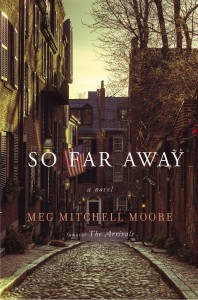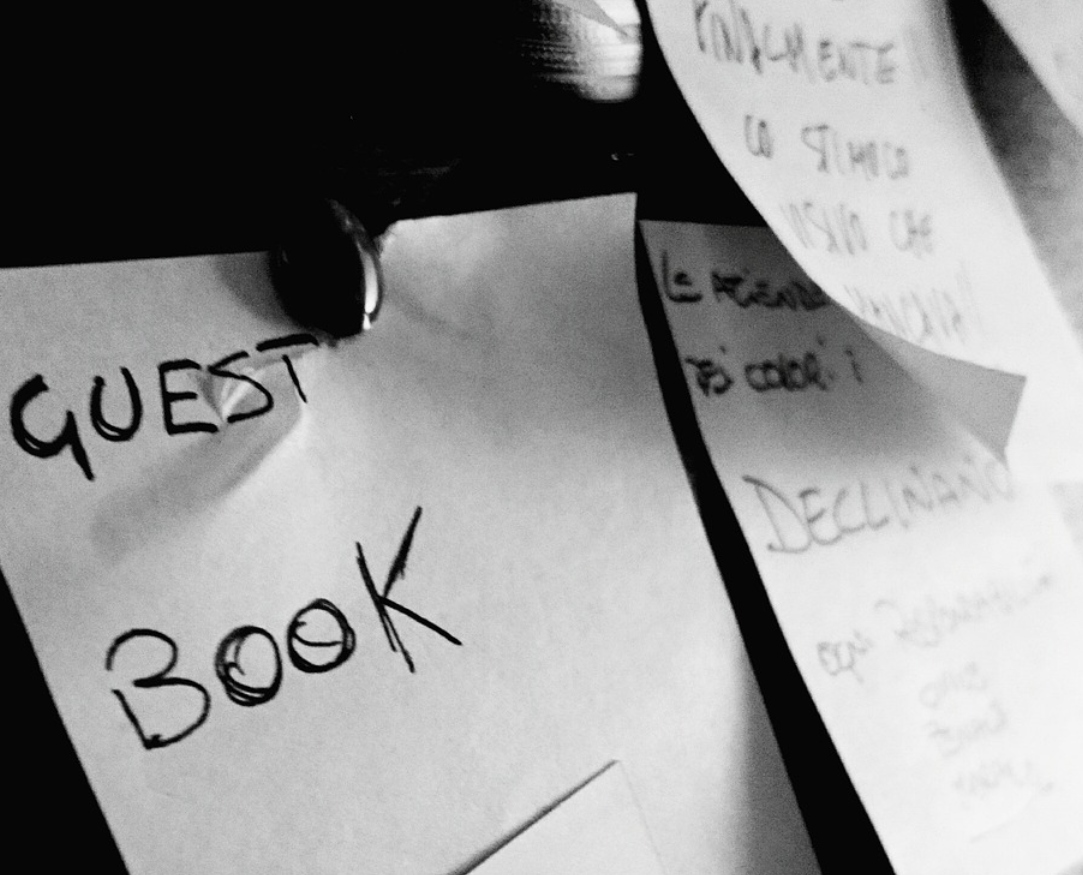The Social Network
By Guest | May 27, 2012 |
 Today’s guest is author Meg Mitchell Moore. Her critically acclaimed debut novel, The Arrivals, was just released in paperback. And her highly-anticipated second book, So Far Away, about the lives of a wayward teenager and a lonely archivist that are unexpectedly joined through the discovery of an old diary, will be released May 29th.
Today’s guest is author Meg Mitchell Moore. Her critically acclaimed debut novel, The Arrivals, was just released in paperback. And her highly-anticipated second book, So Far Away, about the lives of a wayward teenager and a lonely archivist that are unexpectedly joined through the discovery of an old diary, will be released May 29th.
More about So Far Away:
Thirteen-year-old Natalie Gallagher is trying to escape: from her parents’ ugly divorce, and from the vicious cyber-bullying of her former best friend. She discovers a dusty old diary in her family’s basement and is inspired to unlock its secrets.
Kathleen Lynch, an archivist at the Massachusetts State Archives, has her own painful secrets: she’s a widow estranged from her only daughter. Natalie’s research brings her to Kathleen, who in Natalie sees traces of the daughter she has lost.
What could the life of an Irish immigrant domestic servant from the 1920s teach them both? In the pages of the diary, they will learn that their fears and frustrations are timeless.
We’re so glad Meg’s with us today to share her insights on why and how she decided to write about the topic of cyber-bullying in So Far Away.
The Social Network
When an author includes in a fictional work a current social issue, he or she faces certain challenges and responsibilities. I thought Anita Shreve did a admirable job of meeting these challenges in the novel Testimony, which depicts the fallout from a sex scandal involving teenagers at a New England boarding school. So too did Helen Schulman in last year’s This Beautiful Life, which examines one family’s deterioration following a sexting incident. I recently spent some time thinking about these books and wondering why and how they worked, and I decided that it was because the books themselves didn’t serve as comments or judgments on videotaped teenage sex or sexting; they used these very particular and very modern issues to explore universal human experiences and reactions.
I was thinking about these books because my second novel, So Far Away, has a teenage cyberbullying victim as one of its three main characters, and a few recent interviewers have asked me about how and why I chose to write about the topic.
The why is pretty simple.
 When I first pulled together the plan for the novel I knew my 13-year-old character was struggling with something, but at first it was merely her parents’ separation. I really wanted to up the stakes for her, and cyberbullying was and is so much in the news that I started thinking about how terrifying a cyberbullying experience would be for an already fragile young girl. The more I read about the topic, the more I knew I wanted to explore those fears.
When I first pulled together the plan for the novel I knew my 13-year-old character was struggling with something, but at first it was merely her parents’ separation. I really wanted to up the stakes for her, and cyberbullying was and is so much in the news that I started thinking about how terrifying a cyberbullying experience would be for an already fragile young girl. The more I read about the topic, the more I knew I wanted to explore those fears.
The how is a bit more complex, and ultimately it involved trading in my novelist’s cap for a journalist’s cap (long unused, but still hanging in the mental closet). Many outside sources were invaluable to me during the writing of the book—they included a wonderful employee at the Massachusetts Archives, the curator of my local historical society, a couple of doctor friends, and my cyberbullying expert, a professor at the University of Wisconsin-Eau Claire and a co-founder of the Cyberbullying Research Center. I found him through a Google search and approached him the way I used to approach sources in my journalism days, with a mixture of hope, trepidation and awe at people’s ability to master at a topic I knew little about.
This kind and patient person allowed me to interview him several times by phone and tirelessly answered my followup emails. He offered me a few scenarios that a teenage victim of cyberbullying might encounter. He helped me figure out how adults in this girl’s world might react—both correctly and incorrectly—to bullying incidents, and what the fallout might be.
Once I had the facts, I switched back to the novelist cap, and this is where, of course, some of the most important work happened. Though cyberbullying is a crucial element of the book, it is not the only element. And even if it had been, I didn’t want the novel to read like a journalist’s treatise on the topic. I didn’t want to judge my 13-year-old character or any of the adults around her. I wanted their fears, thoughts and actions to speak for themselves, and I wanted them to fit into the overall narrative, which included two other main characters with seemingly unconnected storylines.
Then—and here’s the most important part—I didn’t let myself be finished when I thought I was finished. I went right back to my cyberbullying expert and asked him (a very busy man, involved in his own teaching and writing and family life) to read a close-to-final draft of the book and give me an honest assessment of where I’d gone right and wrong. He did it! And I will be forever grateful.
 In preparing for this post I looked back through my inbox to see when I first contacted my expert. Tomorrow it will be exactly two years since my initial email to him. (I don’t know if that detail is truly telling or not but it seems significant to me.) And so, two years later, I am indebted by people’s willingness to share what they know with random authors they’ve never met. I am humbled by the responsibility I feel to treat an issue as important as cyberbullying with honesty and care. And I’m grateful to the authors who have shown me how to do it right.
In preparing for this post I looked back through my inbox to see when I first contacted my expert. Tomorrow it will be exactly two years since my initial email to him. (I don’t know if that detail is truly telling or not but it seems significant to me.) And so, two years later, I am indebted by people’s willingness to share what they know with random authors they’ve never met. I am humbled by the responsibility I feel to treat an issue as important as cyberbullying with honesty and care. And I’m grateful to the authors who have shown me how to do it right.
Readers, you can learn more about Meg Mitchell Moore on her website; and follow her on Facebook and Twitter.










Meg, your book shines light onto an issue of major threat and angst for this generation’s youngsters. (My use of the word ‘youngsters’ sure gives away my era, doesn’t it?) What a scourge on a young person trying to navigate the minefield of acceptance with a shred of dignity intact. One malavelent person can ruin a life…or take a life. All I had to worry about were fist fights or getting caught smoking. Much work is needed to combat cyberbullying and your book will be a great help.
Thank you, Alex! Yes, I completely agree. I really feel for my daughters when I think about what a complex world they are growing up in. Everything seems just that much scarier than it did when I was a teenager. I know one novel can’t work magic, but I hope to get the conversation started and keep it going among readers.
How about ‘malevolent’? (Check BEFORE submitting, dumbo. Sigh.)
Thanks for sharing this Meg! It was interesting to see your research process and how you decided to approach the novel. It would be easy to end up writing a book that takes a soapbox approach or that of journalistic reporting. But the more powerful approach is the one you chose. That is to show how cyberbullying impacts the victim and her family through their words and actions.
Roxanne,
Yes, I think that is the challenge of writing about any of these topics…you put it perfectly. Thanks for weighing in!
Meg,
What a timely and fascinating premise. Thanks for sharing your research methods with us. As a former newspaper reporter, I thought you went about it the right way. The hard part must have been weaving what you learned into the story without it coming across as an information dump. That takes great skill.
By the way, I also liked Anita Shreve’s Testimony, and her other works as well.
Congratulations on publication of your book and I love the cover.
Thank you so much, CG. I can take no credit for the cover but I love it too. And I LOVE Anita Shreve! I am happy to have the nonfiction work in my background as I think those skills really do come in handy. I bet you find the same with your newspaper background.
Meg,
This is a topic that needed and still needs to be explored in a venue that young people will read. I am a retired high school teacher and have seen first hand how bullying can affect students.
Now that cyberbullying has replaced personal bullying, it is even worse because of young people’s constant use of technology. Glad you tackled it.
Janys
Thanks, Janys. This is unfortunately all too true. Adding technology to the already odious practice of bullying really does raise everything to a whole new level. I admire the work the schools in my area are doing to combat it, but what a scary thing for today’s teenagers. Thanks for commenting!
It sounds like a job well done, Meg. I look forward to reading this new novel as my daughter is on the cusp of her teenage years. She is a rare bird in her flock of classmates in that she doesn’t have an iTouch, cell phone, or Facebook account. Sadly, cyberbullying is part of their world. Kudos to you for digging into it and providing a “real world” view for parents that have yet to deal with it firsthand.
Thanks, Hallie! And kudos to YOU for guiding your daughter through these treacherous waters. My three girls haven’t reached the ages where their friends have all of those tools but I know we are inching closer to it and I just hope awareness and conversation is enough to combat some of the negative experiences kids can have. At the same time, technology can help kids in so many ways too that it’s a fine line to walk…how much is too much, etc. It’s a constant question in our house! Let me know if you learn any answers.
Dear Meg:
Cyber bullying was pretty much a foreign concept to me until I read your post. What you’d shared about finding and working with an expert on the topic brought me significant reassurance. Up until now, I’ve limited my to subject matters within my own experiences and those of family members and close friends. (Approaching strangers felt, and still feels, imtimidating.) Now, however, I am inspired to bravely don a journalist’s hat and wade into some uncharted terrirory!
Teenage blues. We’ve all been there. Congratulations on the release Meg. Looking forward to reading the book.